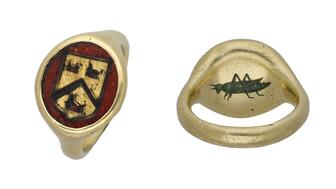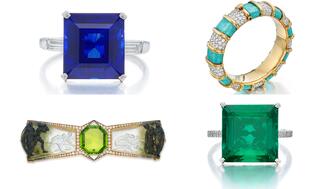The heist happened in Lebec, California, in 2022 when a Brinks truck was transporting goods from one show in California to another.
How GIA Is Changing Its Reports for Lab-Grown Diamonds
The lab has dropped the word “synthetic” from the document and added standard scales for reference.

Carlsbad, Calif.—The Gemological Institute of America is tweaking the grading reports it issues for man-made diamonds, dropping the word “synthetic” but still not using the same scale it does for natural diamonds.
Beginning July 1, the GIA Synthetic Diamond Grading Report will become the GIA Laboratory-Grown Diamond Report. The word “synthetic” also will be removed from the “Identification” line, replaced with the words “laboratory-grown.”
The elimination of synthetic is in keeping with recent revisions the Federal Trade Commission made to its Jewelry Guides, removing the word from its list of recommended terms for lab-grown diamonds because of “the likelihood of consumer confusion.”
GIA also is now including the standard color, clarity and cut grading scales on the reports, but for reference purposes only; the lab still will not apply the scales it uses for natural diamonds to man-made stones.
As the lab has done since it first started offering reports for man-made diamonds in January 2007, it will use: colorless, near colorless, faint, very light and light to report color grades on man-made diamonds, not D-Z.
However, colorless, near colorless, etc. will be listed alongside the D-Z scale so consumers can see, for example, that a near-colorless lab-grown diamond is the equivalent of a natural diamond that’s graded between G and J.
For clarity, GIA will continue to use: flawless, internally flawless, very very slightly included, very slightly included, slightly included and included.
Like color, these terms will appear alongside the standard clarity grade scale for reference. A very very slightly included lab-grown diamond, for example, is equal to VVS1 or VVS, while a lab-grown diamond graded as slightly included is like an SI1 or SI2 mined diamond.
The GIA scale for cut grade, which ranges from excellent to poor, also is included on the new lab-grown diamond report. GIA always has used the same cut-grade terms for both natural and lab-grown diamonds.
When asked why it opted not to grade lab-grown diamonds exactly liked mined stones—as HRD Antwerp just did—the lab gave essentially the same reasons Executive Vice President and Chief Laboratory and Research Officer Tom Moses did when interviewed by National Jeweler in October 2016.
“Laboratory-grown diamonds do not have the same range of color as mined diamonds and are generally grown to be as close to colorless as possible or are treated post-growth to make them colorless or near colorless,” GIA said when asked about the changes this week.
“This is why GIA uses words rather than letters (for example D-Z) or abbreviations (for example VVS and SI2) to report grades for color and clarity of laboratory-grown diamonds.”
The lab also noted that it made the changes it did to “provide more information to consumers.”
Also on the Laboratory-Grown Diamond Report, GIA said it will disclose all detected clarity treatments and include the following statement regarding possible color treatment: “This is a man-made diamond produced by CVD (Chemical Vapor Deposition) or HPHT (High Pressure High Temperature) growth processes and may include post-growth treatments to change the color.”
GIA said the previous reports for man-made diamonds also noted any clarity treatements. Color treatments also were disclosed for a time, though the Synthentic Diamond Grading Report did not include the above general statement that will appear on the new reports.
Any GIA Synthetic Diamond Grading Report issued since Jan. 1, 2018, can be returned and exchanged for the new Laboratory-Grown Diamond Report at no cost.
The price of a GIA Laboratory-Grown Diamond Report is the same as a GIA Diamond Grading Report, and, like the natural diamond reports, the QR code on the lab-grown reports link to GIA’s online Report Check Service. The report check record for man-made diamonds will include educational information about the CVD and HPHT diamond-growing processes.
The topic of lab-grown diamond grading stirs debate in the industry, with some questioning why GIA does not just grade lab-grown diamonds the same way as it does natural diamonds, since they share the same chemical, optical and physical properties and are, in fact, diamonds.
It is the approach HRD Antwerp took, with the Belgian lab noting the need for “better transparency” in an age when the man-made stones are becoming more prevalent.
Others, however, agree with GIA’s stance, citing the need for differentiating lab-grown diamonds from mined ones and the lack of color and clarity range in the man-made material.
The Latest

The 10-carat fancy purple-pink diamond with potential links to Marie Antoinette headlined the white-glove jewelry auction this week.

The Starboard Cruises SVP discusses who is shopping for jewelry on ships, how much they’re spending, and why brands should get on board.

The Seymour & Evelyn Holtzman Bench Scholarship from Jewelers of America returns for a second year.

The historic signet ring exceeded its estimate at Noonans Mayfair’s jewelry auction this week.


To mark the milestone, the brand is introducing new non-bridal fine jewelry designs for the first time in two decades.

The gemstone is the third most valuable ruby to come out of the Montepuez mine, Gemfields said.

The countdown is on for the JCK Las Vegas Show and JA is pulling out all the stops.

Founder and longtime CEO Ben Smithee will stay with the agency, transitioning into the role of founding partner and strategic advisor.

Associate Editor Natalie Francisco shares 20 of her favorite pieces from the jewelry collections that debuted at Couture.

If you want to attract good salespeople and generate a stream of “sleeping money” for your jewelry store, then you are going to have to pay.

The top lot was a colorless Graff diamond, followed by a Burmese ruby necklace by Marcus & Co.

Gizzi, who has been in the industry since 2001, is now Jewelers of America’s senior vice president of corporate affairs.

Luca de Meo, a 30-year veteran of the auto industry, will succeed longtime CEO François-Henri Pinault.

Following visits to Vegas and New York, Botswana’s minerals minister sat down with Michelle Graff to discuss the state of the diamond market.

The “Your Love Has the Perfect Ring” campaign showcases the strength of love and need for inclusivity and representation, the jeweler said.

The former De Beers executive is the jewelry house’s new director of high jewelry for the Americas.

The New York Liberty forward is the first athlete to represent the Brooklyn-based jewelry brand.

Take a bite out of the 14-karat yellow gold “Fruits of Love Pear” earrings featuring peridots, diamond stems, and tsavorite leaves.

The one-day virtual event will feature speakers from De Beers, GIA, and Gemworld International.

The California-based creative talks jewelry photography in the modern era and tackles FAQs about working with a pro for the first time.

Al Capone’s pocket watch also found a buyer, though it went for less than half of what it did at auction four years ago.

The foundation has also expanded its “Stronger Together” initiative with Jewelers for Children.

Assimon is the auction house’s new chief commercial officer.

The De Beers Group CEO discusses the company’s new “beacon” program, the likelihood diamonds will be exempt from tariffs, and “Origin.”

The Danish jewelry giant hosted its grand opening last weekend, complete with a Pandora pink roulette wheel.

The winners of the inaugural “Kering Generation Award x Jewelry” are student Lee Min Seo and China-based startup Ianyan.

























